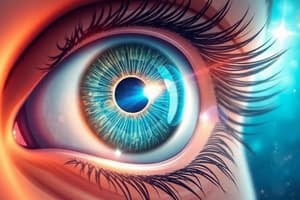Podcast
Questions and Answers
Which of the following is directly stimulated by light?
Which of the following is directly stimulated by light?
- Occipital lobe
- Retina
- Photoreceptors (correct)
- Optic nerve
Vision is experienced within the photoreceptors.
Vision is experienced within the photoreceptors.
True (A)
Phantom limb pain is an example of adaptation.
Phantom limb pain is an example of adaptation.
False (B)
Pain is experienced in the brain and not in the thumb.
Pain is experienced in the brain and not in the thumb.
What is the main study focus of ophthalmology?
What is the main study focus of ophthalmology?
What role do eyebrows play?
What role do eyebrows play?
What do lacrimal apparatus produce?
What do lacrimal apparatus produce?
What type of receptors respond to tissue damage?
What type of receptors respond to tissue damage?
Pain receptors adapt to continuous stimulation.
Pain receptors adapt to continuous stimulation.
Name an example of pain in the tissues surrounding the brain.
Name an example of pain in the tissues surrounding the brain.
Match the following types of senses with their corresponding organs:
Match the following types of senses with their corresponding organs:
Flashcards are hidden until you start studying
Study Notes
The Sensory System
- The sensory system receives stimuli from the environment and transmits signals to the brain for interpretation.
- The four components of the sensory system are: stimulus, receptor, sensory nerve, and brain.
- Stimulus: The initial trigger or input (e.g., light, sound, pressure).
- Receptor: Receives the stimulus (e.g., photoreceptors for light).
- Sensory nerve: Transmits the signal from the receptor to the brain.
- Brain: Processes the signal and interprets it.
- Projection: The brain projects the sensation back to the source of the stimulus, even if the actual source has been removed (e.g., phantom limb pain).
- Phantom limb pain: Pain experienced in a missing limb due to the brain's continued perception of the limb.
Sense of Sight: The Eye
- Ophthalmology: The study of the eye and its functions.
- Visual accessory organs: Structures that support vision but aren't directly involved in light detection.
- Eyebrows: Protect the eyes from sweat, glare, and play a role in facial expressions.
- Eyelids (Palpebrae): Protect the eyes from foreign objects, dust, and debris; wash the eye's surface.
- Lacrimal apparatus: Produces tears to lubricate and cleanse the eyes.
General Senses
- Pain: Sensory receptors that respond to tissue damage (nociceptors).
- Nociceptors: Do not adapt to the stimulus; they continue to send signals even after the initial stimulus is removed.
- Pain receptors: Found throughout the skin and internal tissues; the brain lacks pain receptors.
- Protective function: Pain serves as a warning signal, motivating individuals to address the issue causing the pain.
- Example: A headache is pain in the tissues surrounding the brain (meninges and blood vessels).
Special Senses
- Special senses: Smell, taste, sight, hearing, and balance.
- Smell: Olfactory receptors in the nose detect odor molecules.
- Taste: Taste buds on the tongue detect different tastes (sweet, sour, salty, bitter, umami).
- Sight: Photoreceptors in the eye detect light.
- Hearing: Hair cells in the inner ear (cochlea) detect sound waves.
- Balance: Vestibular apparatus in the inner ear detects head movements and gravity.
Studying That Suits You
Use AI to generate personalized quizzes and flashcards to suit your learning preferences.




